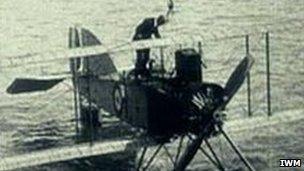Obituary: Claude Choules
- Published
The BBC's Robert Hall takes a look back at Claude Choules' life
Claude Choules was the last known surviving combat veteran of the Great War, and served in both the world wars of the 20th Century.
Born in Pershore, Worcestershire in 1901, he tried to sign up for the army at the beginning of World War I but he was too young.
Two years later, at the age of 15, he joined the Royal Navy serving on board the training ship HMS Impregnable based at Devonport.
His earliest memories in the service were of seeing the convoys of ships, returning to Britain, carrying the wounded from the Battle of the Somme.
In 1917 he transferred to the battleship HMS Revenge, one of the newest and most powerful ships in the British fleet and the flagship of the First Battle Squadron.
German surrender
His main task on the Revenge was to help lower the seaplanes into the water which were used to fight the threat of German Zeppelins.
It was while on board the Revenge that Choules witnessed the surrender of the German High Seas Fleet in November 1918 in the Firth of Forth.
He remained with the Revenge as part of the escort which accompanied the German fleet to Scapa Flow in the Orkney Islands and, six months later, watched as the interned German crews scuttled their ships.
Choules was posted to the Mediterranean in 1920 where he spent nearly three years on the battleship HMS Valiant before joining HMS Eagle, the Royal Navy's first purpose built aircraft carrier.

Seaplanes were used to counter threats from German Zeppelins
In 1926, along with a number of senior sailors he was sent to Australia to work as an instructor at the Flinders Naval Depot near Adelaide.
He was so taken by the Australian way of life that he applied for a transfer to the Royal Australian Navy where he became a specialist torpedo and explosives expert.
He was part of the crew that travelled to Scotland to commission the newly built warship HMAS Canberra and he served in her until 1931 when he transferred to the navy reserve.
In 1932 he rejoined the regular Australian navy as a Chief Petty Officer Torpedo and Anti Submarine Instructor.
Explosives in Australia
At the outbreak of war in 1939 Choules was the Acting Torpedo Officer, Fremantle and also the Chief Demolition Officer on the western side of the Australian continent.
He was tasked with destroying vital military installations should the threatened Japanese invasion of Australia come to pass.
Early in the war he was flown to Esperance, on the south coast of Western Australia, to identify and destroy the first mine to wash up on Australian soil during World War II.
As a demolition and explosives expert he took charge of the operation to clear the wreckage of 15 flying boats from the port of Broome on the northern coast of Western Australia.
The aircraft had been destroyed in an earlier Japanese attack and the remains were blocking a vital navigation.
Choules and his team of divers arrived in December 1942 and spent three months using explosives to blow the wrecks into manageable pieces and transport them into deeper water away from the harbour.

Taking to the skies on his 103rd birthday
He had the task of destroying Fremantle harbour and oil storage tanks rendering them useless as facilities in the event of a Japanese invasion.
Choules placed explosives around the harbour facilities and on board those ships that could not be moved to a safer harbour.
He remained in the Australian Navy until he transferred to the Naval Dockyard police, finally retiring in 1956 after 40 years in uniform.
For the next 10 years he operated a boat catching crayfish off the coast of Western Australia.
As, one by one, his fellow veterans passed away he must have felt history was closing in on him. But, although his body was failing, his mind remained alert until the end.
"I'm lucky aren't I, to be surviving all that time," he once told the BBC. "If I had my time over again I wouldn't change a bit of it"
Claude Choules was the last link with a war that wiped out a generation. Now, like the conflict in which he fought, he has passed into history.